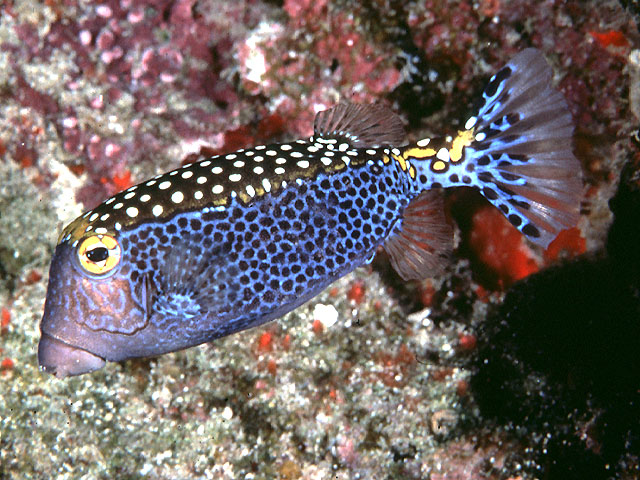| Ostraciidae (Boxfishes) |
| 25 cm TL (male/unsexed) |
|
reef-associated; marine; depth range 0 - 30 m |
| Indo-Pacific and Eastern Pacific: East Africa to the Mexico, north to southern Japan and the Hawaiian Islands, south to New Caledonia and the Tuamoto Islands. The subspecies Ostracion meleagris camurum is found in the Hawaiian Islands and Ostracion meleagris clippertonense in the Eastern Pacific. Species replaced by Ostracion cyanurus in Red Sea and Gulf of Aden. |
|
Dorsal spines (total): 0-0; Dorsal soft rays (total): 9-9; Anal spines: 0-0; Anal soft rays: 9-9. Juveniles and females brown or green with white spots; large males with orange bands and spots on side of body (Ref. 3141). Caudal fin rays 10 (Ref. 3141). Sexually dimorphic (Ref. 37816).
Description: Characterized further by having quadrangular carapace in cross section, absence of conspicuous bulge; more or less straight dorsal profile of snout, lacking bony protuberance above upper lip; rounded caudal fin (Ref. 90102). |
| Inhabits clear lagoon and seaward reefs from the lower surge zone to at least 30 meters (Ref. 37816, 48637). Juveniles among rocky boulders, often with long spined urchins, and adults on reef crests and slopes. Males swim about more openly than females that are often in close vicinity to the males (Ref. 48637). Solitary. Feeds on didemnid tunicates, polychaetes, sponges, mollusks, copepods, and algae (Ref. 37816). Minimum depth reported taken from Ref. 128797. |
|
Least Concern (LC); Date assessed: 14 August 2023 Ref. (130435)
|
| venomous |
Source and more info: www.fishbase.org. For personal, classroom, and other internal use only. Not for publication.
